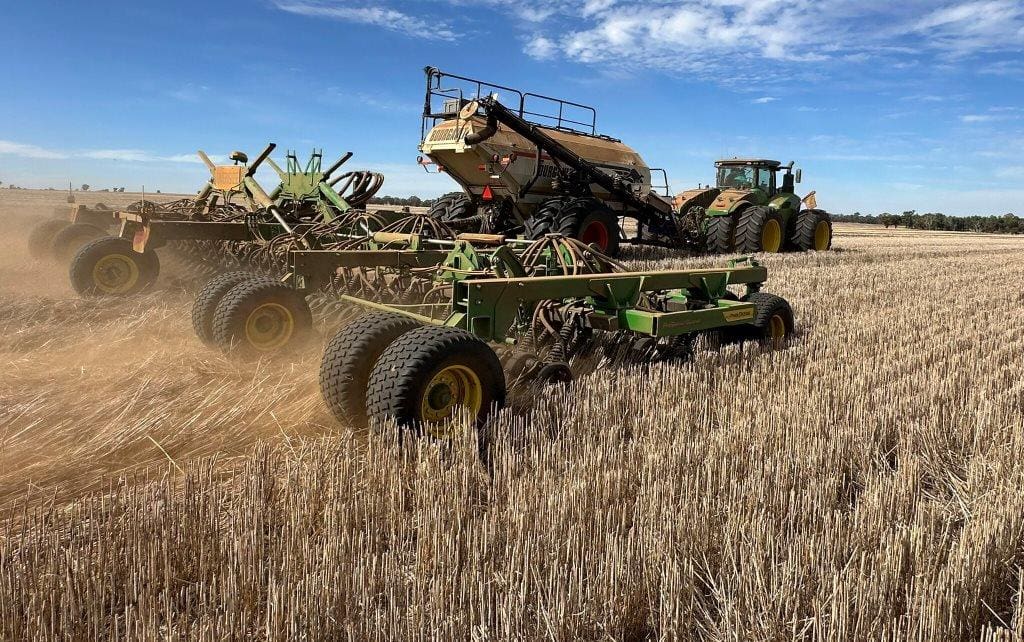
NSW growers are well advanced on canola planting in areas including Thuddungra on the south-west slopes. Photo: Grassroots Agronomy
GROWERS across Australia are busy planting their winter crops and traded volume has entered its annual lull.
Most consumers are well covered into June, and hoping for an uptick in grower selling once the main planting window closes in early June.
As bulk wheat and barley exports tail off, grower and trade attention is on the southern domestic market as the wait continues for an autumn break to appear on the Bureau of Meteorology forecast.
| May 1 | Today | |
| Barley Downs | $330 | $332 |
| ASW Downs | $350 | $350 |
| Sorghum Downs | $365 | $360 |
| Barley Melbourne | $363 | $367 |
| ASW Melbourne | $370 | $370 |
Table 1: Indicative prices in Australian dollars per tonne.
North
Queensland and the northern half of New South Wales are off to a flying start with their winter-cropping programs.
Canola and faba beans are already in, and growers are now moving into wheat and barley.
One trader said the rosy start to the season has this week prompted some growers to seek bids for cereals stored on farm.
“There’s a lot of grain going in…and some are asking themselves why they are waiting for the new financial year before they sell what’s on farm,” he said.
“We are starting to see a bit more white grain hit the market.”
The presence of weevils, the result of warm and damp conditions in recent weeks, has caused some loads to be rejected by consumers or bulk handlers.
However, most growers have done a good job keeping their grain insect-free, or fumigating it in sealed storages.
Bulk sorghum exports are continuing at pace, with the Brisbane market trading at a $30/t premium over the Downs to indicate the market’s preference to own it at port rather than up country.
“There’s a big difference between the Downs and Brisbane; it’s probably $10/t more than it normally is.”
While conditions across the north are generally ideal for planting, and too wet in places, Knight Commodities Goondiwindi-based broker Gerard Doherty said a few pockets could do with some rain.
“It’s dry around Dalby…and some people have stopped planting,” Mr Doherty said.
While dry conditions in South Australia and Victoria are on everyone’s mind, Mr Doherty said they have not been enough to break the northern market out of its rangebound period.
“It’s been moving around by $5 for three or four months.
“We might see more selling inquiry on the back of the new financial year, but not while there’s no rain on the forecast to see.”
Northern consumers are generally seen as well covered, and many bought up big at harvest, when prices were considerable cheaper.
Southern
Dry sowing in SA and Vic is advancing, with growers taking comfort in the fact that history points to a rain event by early June to germinate crops.
However, little to no subsoil moisture, and the fact that we are a week into May, has growers in the Riverina region of NSW dropping canola from rotations and looking at shorter-season barley.
“I’d say there’s 70-80pc of the crop in the ground,” one southern consumer said.
“Soil temperatures are still pretty warm, so that will be good for germination.”
What is needed is rain, but only a few millimetres at best are on the forecast for Vic’s main cropping areas, the Mallee and Wimmera, SA’s main cropping areas, and southern NSW.
“Growers are still holding on very tight to the grain they have.”
Once it rains, growers are expected to sell some wheat and barley.
The consumer said the new-crop outlook is of more concern.
“We’re more worried about next year, when stocks are going to be in the north.”
Demand from graziers and mixed farmers looking for grain to feed sheep and cattle is creeping north and on to the Southern Tablelands of NSW.
“It’s running up the Hume Highway now,” one trader said.
With export values for faba beans, field peas, and lupins all at $600/t plus up-country, barley remains a more affordable option.
“From Anzac Day to the end of May is when growers are tied up with planting their crops, and the market knows that, although there are always one or two caught short,” one trader said.

HAVE YOUR SAY